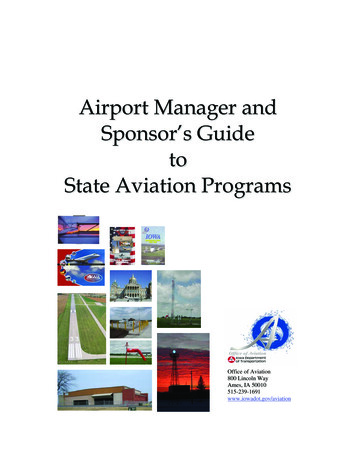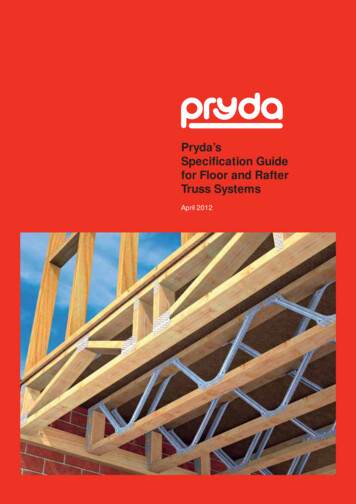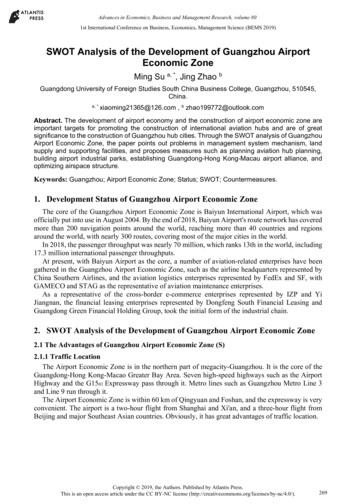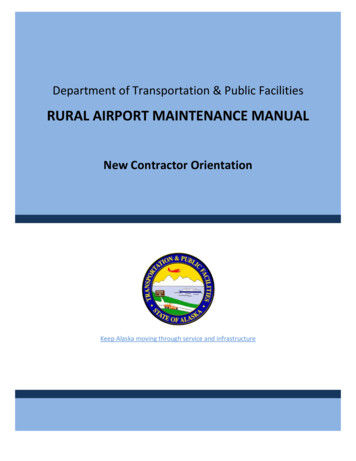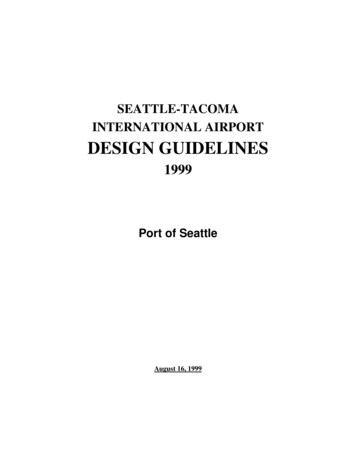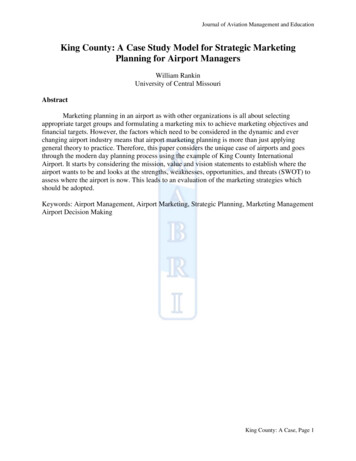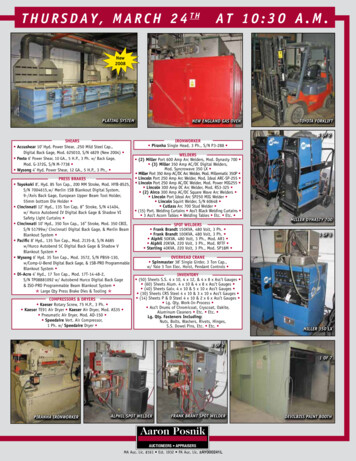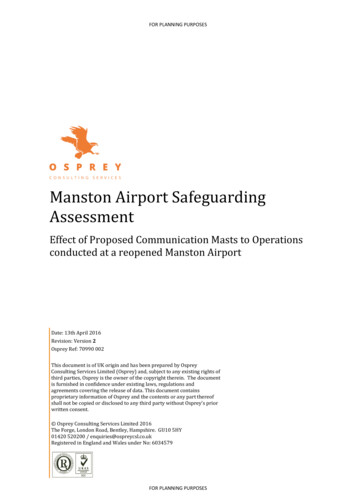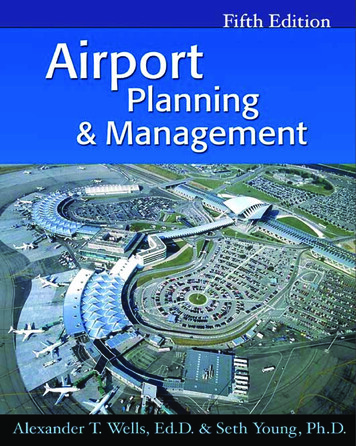
Transcription
AirportPlanning &Management
This page intentionally left blank.
AirportPlanning &Management5th EditionAlexander T. Wells, Ed.D.Seth B. Young, Ph.D.McGraw-HillNew York Chicago San Francisco Lisbon LondonMadrid Mexico City Milan New Delhi San JuanSeoul Singapore Sydney Toronto
Copyright 2004, 2000, 1996, 1992, 1986 by The McGraw-Hill Companies, Inc.All rights reserved. Manufactured in the United States of America. Except as permitted under theUnited States Copyright Act of 1976, no part of this publication may be reproduced or distributed in any form or by any means, or stored in a database or retrieval system, withoutthe prior written permission of the publisher.0-07-143606-5The material in this eBook also appears in the print version of this title:0-07-141301-4.All trademarks are trademarks of their respective owners. Rather than put a trademark symbol after every occurrence of a trademarked name, we use names in an editorial fashiononly, and to the benefit of the trademark owner, with no intention of infringement of thetrademark. Where such designations appear in this book, they have been printed with initial caps.McGraw-Hill eBooks are available at special quantity discounts to use as premiums andsales promotions, or for use in corporate training programs. For more information, pleasecontact George Hoare, Special Sales, at george hoare@mcgraw-hill.com or (212) 904-4069.TERMS OF USEThis is a copyrighted work and The McGraw-Hill Companies, Inc. (“McGraw-Hill”) and itslicensors reserve all rights in and to the work. Use of this work is subject to these terms.Except as permitted under the Copyright Act of 1976 and the right to store and retrieve onecopy of the work, you may not decompile, disassemble, reverse engineer, reproduce, modify, create derivative works based upon, transmit, distribute, disseminate, sell, publish orsublicense the work or any part of it without McGraw-Hill’s prior consent. You may use thework for your own noncommercial and personal use; any other use of the work is strictlyprohibited. Your right to use the work may be terminated if you fail to comply with theseterms.THE WORK IS PROVIDED “AS IS.” McGRAW-HILL AND ITS LICENSORS MAKE NO GUARANTEES OR WARRANTIES AS TO THE ACCURACY, ADEQUACY OR COMPLETENESS OFOR RESULTS TO BE OBTAINED FROM USING THE WORK, INCLUDING ANY INFORMATION THAT CAN BE ACCESSED THROUGH THE WORK VIA HYPERLINK OR OTHERWISE, AND EXPRESSLY DISCLAIM ANY WARRANTY, EXPRESS OR IMPLIED, INCLUDINGBUT NOT LIMITED TO IMPLIED WARRANTIES OF MERCHANTABILITY OR FITNESS FORA PARTICULAR PURPOSE. McGraw-Hill and its licensors do not warrant or guarantee thatthe functions contained in the work will meet your requirements or that its operation willbe uninterrupted or error free. Neither McGraw-Hill nor its licensors shall be liable to youor anyone else for any inaccuracy, error or omission, regardless of cause, in the work orfor any damages resulting therefrom. McGraw-Hill has no responsibility for the content ofany information accessed through the work. Under no circumstances shall McGraw-Hilland/or its licensors be liable for any indirect, incidental, special, punitive, consequential orsimilar damages that result from the use of or inability to use the work, even if any of themhas been advised of the possibility of such damages. This limitation of liability shall applyto any claim or cause whatsoever whether such claim or cause arises in contract, tort orotherwise.DOI: 10.1036/0071436065
Want to learn more?We hope you enjoy thisMcGraw-Hill eBook! Ifyou’d like more information about this book,its author, or related books and websites,please click here.
For more information about this title, click here.ContentsAcknowledgmentsPreface xiiixiPart I: Airports and airport systems 11 Airports and airport systems: An introductionIntroduction 4Airport management on an international level 10The National Plan of Integrated Airport Systems—The Nation’sAirport System Plan 11The rules that govern airport management 19Organizations that influence airport regulatory policies 22Concluding remarks 252 Airports and airport systems: Organizationand administration 29Introduction 30Airport ownership and operation 30The airport organization chart 34Airport management as a career 43The airport manager and public relationsConcluding remarks 50463 Airports and airport systems:A historical and legislative perspective53Introduction 54The formative period of aviation and airports: 1903–1938 55Airport growth: World War II and the postwar period 60Airport modernization: The early jet age 63Airport legislation after airline deregulation 73Airports in the twenty-first century: From peacetime prosperityto terror insecurity 83Concluding remarks 92v3
viContentsPart II: The components of the airport 974 The airfield99The components of an airport 100The airfield 102Navigational aids (NAVAIDS) located on airfields 136Air traffic control and surveillance facilities located on the airfield 143Weather reporting facilities located on airfields 145Security infrastructure on airfields 148Concluding remarks 1485 Airspace and air traffic control153Introduction 154Brief history of air traffic control 154The present-day air traffic control management and operatinginfrastructure 158The basics of air traffic control 160Current and future enhancements to air traffic control 167Concluding remarks 1896 Airport terminals and ground accessIntroduction 194The historical development of airport terminalsComponents of the airport terminal 209Airport ground access 228Concluding remarks 243193195Part III: Airport operations andfinancial management 2497 Airport operations management underFAR Part 139 251Introduction 252Pavement management 253Aircraft rescue and fire fighting (ARFF) 259Snow and ice control 264Safety inspection programs 270Bird and wildlife hazard management 273Concluding remarks 275
Contents8 Airport securityvii279Introduction 280History of airport security 280The Transportation Security Administration 285Security at commercial service airports 288Security at general aviation airports 299The future of airport security 303Concluding remarks 3049 Airport financial management309Introduction 311Airport financial accounting 311Revenue strategies at commercial airports 318Pricing of airport facilities and services 322Variation in the sources of operating revenues 326Rise in airport financial burdens 327Airport funding 328Grant programs 328Airport financing 334Private investment 340Sale of the airport 342Concluding remarks 342Part IV: Airport public administrationand planning 34510 The economic, political, and social roleof airports 347Introduction 348The economic role of airports 348Political roles 350Environmental impacts of airports 354Concluding remarks 36111 Airport planning365Introduction 367Airport system planning 368The airport master plan 373The airport layout plan 378Forecasting 380
viiiContentsFacilities requirements 387Design alternatives 389Financial plans 400Land use planning 404Environmental planning 406Concluding remarks 40812 Airport capacity and delay413Introduction 414Defining capacity 415Factors affecting capacity and delay 417Estimating capacity 421Illustrating capacity with a time-space diagram 423FAA approximation charts 426Simulation models 428Defining delay 430Estimating delay 432Analytical estimates of delay: The queueing diagram 433Other measures of delay 435Approaches to reducing delay 436Administrative and demand management 438Concluding remarks 45013 The future of airport management461Introduction 461Restructuring of commercial air carriers 462New large aircraft 462Small aircraft transportation systems 464Concluding remarks 467Code of Federal Regulations: 14 CFR—Aeronauticsand Space, Parts 1 through 199 469Code of Federal Regulations: 49 CFR—1500 Series:Transportation Security Regulations 473Federal Aviation Administration 150 SeriesAdvisory Circulars 475
ContentsPhonetic alphabetAbbreviationsGlossaryIndex501549493495ix
This page intentionally left blank.
AcknowledgmentsI am sincerely appreciative of the many public and private institutions thathave provided resource material from which I was able to shape this text. Inthis regard, I am particularly indebted to the Federal Aviation Administrationfor their numerous publications.Faculty and students at University Aviation Association institutions who havereviewed material in the previous four editions have significantly shaped thisbook. To them I owe a special thanks because they represent the true constituency of any textbook author.I am also indebted to many practicing airport planners and managers for theirideas and to the American Association of Airport Executives (AAAE) whoadopted this book in their certification program for a number of years beforedeveloping their own material.Finally, I must thank my wife, Mary, for considerable patience and encouragement throughout the process.Alex WellsIt is not often that a “young” professor is as lucky to have the opportunity towork so closely with academic and industry leaders as I have. The experiences and education that I have gained from my professional relationshipswith Embry-Riddle Aeronautical University, the American Association of Airport Executives, the University of California at Berkeley, Leigh Fisher Associates, the Federal Aviation Administration, and airport managers throughout theUnited States have been truly remarkable. My sincere thanks go out to all ofmy airport and aviation industry partners. Special thanks, of course, to Dr.Alex Wells, who honored me with the opportunity to co-author the latest edition of this worthy text. I hope that the material found within our text is aptlyable to communicate the great body of information I’ve gained from theirvaluable sources of knowledge.xiCopyright 2004, 2000, 1996, 1992, 1986 by The McGraw-Hill Companies, Inc. Click here or terms of use.
xiiAcknowledgmentsAs an associate professor within Embry-Riddle Aeronautical University’s Collegeof Business, I’ve learned equally as much from our institution’s remarkable students as I hope they have from my instruction. This text goes out to them, andall students interested in the professions associated with airport planningand management. They are indeed the future of this exciting industry.Finally, most special thanks to my friends and family, especially my parents,Rosalie and Dennis Young, whose emphasis on the importance of educationhas penned an indelible mark on my personal and professional life.Seth Young
PrefaceIn 1986, the first edition of Airport Planning & Management pioneered an innovative structure for a basic airport principles course designed for several similar,yet distinct, markets: the college student enrolled in an aviation program, as wellas someone in the field of airport management or operations who is seeking further education. Since that time, four editions of the text were published, eachedition reflecting updates that have occurred in the constantly evolving aviationindustry. The response of both professors and students over the years has beengratifying. Airport Planning & Management and its accompanying test bank havebeen more widely used than any other teaching material for an airport course.In the seventeen years since the first edition of this text was published, theworld of civil aviation, including airport management, has witnessed tremendous changes in technology, structure, and political environments. The airlineindustry adjusted to major regulatory change, experienced economic woes, experienced record economic prosperity, and most recently has begun to adjust toan entirely new economic and political environment. Similarly, general aviationhas witnessed a rebirth in activity and technological developments. In addition,the world of airport management has continued to evolve into more of a scientific discipline, applying theories of operations, economics, finance, and publicadministration to adapt to ever-changing environments.An important change has been the addition of a co-author, Dr. Seth Young,whom I have had the pleasure of working with for the past five years as a fellow professor at Embry-Riddle Aeronautical University. Dr. Young has a Ph.D.in civil and environmental engineering/transportation from the University ofCalifornia, Berkeley, is an accredited certified member of the American Association of Airport Executives, and is a certified instrument-rated FAA private pilot.Prior to his career at Embry-Riddle, Dr. Young was an airport management consultant, participating on airport planning projects throughout the United States.Dr. Young’s expertise in the area of airport planning, operations, and management brings a new dimension to this book.We have made our best attempt to bring the fifth edition of Airport Planning &Management to a new standard of quality as a resource for current and futureairport managers. We have worked hard to enhance the best and proven elementsxiiiCopyright 2004, 2000, 1996, 1992, 1986 by The McGraw-Hill Companies, Inc. Click here or terms of use.
xivPrefaceof the earlier editions while adding new perspectives, theories, and informationgained from our respective teaching, research, and aviation experiences. Thewhole text has been critically revised, updated, and reorganized. In addition, significant text has been added and rewritten. Clear and interesting communicationhas been a priority, as in past editions.Recognizing that a course in airport planning and management is normally a student’s first exposure to the field, this text provides a significant amount of introductory material. While no one text can be the exhaustive source on anyparticular topic, this text attempts to provide a body of information that will allowstudents to gain knowledge of the various facets of airport planning and management at a fundamental, yet also comprehensively rich, level. The focus of this textis to build a solid foundation of understanding of all the elements that are of concern to airport management. Influenced by our combined experience of over 40years in teaching aviation management at the college level, we believe that the information contained in this text is commensurate with university level study.It is recognized that instructors will supplement the material found in this textwith current case studies, examples drawn from their own experiences, timelynews sources, and industry and academic journals. Students are encouraged toexplore and keep abreast of current periodicals, such as Airport, Airport Business, Air Transport World, and Aviation Week and Space Technology. It ishoped that the ability to reason accurately and objectively about problems facing airports and the development of a lasting interest in airport planning andmanagement will be two valuable byproducts of the text’s basic objectives.Organization of the Fifth EditionThe three years since the publication of the fourth edition of this text hasseen perhaps the most dramatic changes in civil aviation, and particularly airport management, since the development of the industry one hundred yearsago. Not coincidentally, the fifth edition of Airport Planning & Managementis a result of the text’s most significant revisions since first publication.The text has been reorganized into four sections: Airports and Airport Systems,The Components of the Airport, Airport Operations and Financial Management,and Airport Public Administration and Planning. Each section is designed toaddress airport planning and management from specific perspectives.Part I: Airports and airport systemsPart I provides an overview of airports from a systems perspective and provides background and historical information regarding the development of airports and the rules that airport management must adhere to. Within this sectionare three chapters.
PrefacexvChapter 1: Airports and airport systems: An introduction provides a comprehensive overview of airports in the United States, the national administrative structure of airports, and provides basic definitions whichdescribe airports and types of airport activity.Chapter 2: Airport and airport systems: Organization and administrationdescribes the public and private ownership and administrative structuresthat exist for civil use airports in the United States and internationally. Acomprehensive sample of employment positions that exist at airports ispresented, as are descriptions of the duties of the airport manager, andan introduction to the public relations issues facing airport management.Chapter 3: Airports and airport systems: A historical and legislative perspective includes an account of the development of airports within the civilaviation system that has been thoroughly reviewed and updated throughearly 2003, including the latest legislation regarding airport funding, and,of course, airport security.Part II: The components of the airportPart II has been written to provide the airport management student, as well asthe new airport management employee, with a comprehensive informationsource describing the facilities that exist within an airport’s property. This section may be valuable not only as a text but also as a reference guide for thosenot in academic study. Within this section are three chapters.Chapter 4: The airfield describes the facilities that exist on an airport to facilitate the operation of aircraft, including a full description of runways, taxiways, and navigational aids, along with associated signage, lighting, andmarkings. Much of the information contained in this chapter is sourceddirectly from the Federal Aviation Administration’s Airman’s InformationManual, a guide designed to provide pilots of civil aircraft with full descriptions of the aviation environment.Chapter 5: Airspace and air traffic control provides a fundamental, yet detailed, description of the national airspace and air traffic control system,as it relates to airport management. A brief history of air traffic control isprovided, as is a description of the management structure of the currentair traffic control system. The basics of air traffic control are described,including the various classes of airspace and the rules by which they areoperated. In addition, a description of the current and future plannedenhancements to the air traffic control system is provided, to allow theairport manager to best prepare for the future of air traffic control.Chapter 6: Airport terminals and ground access describes the infrastructureused to facilitate the transfer of passengers and cargo between aircraftand their ultimate origins and destinations within a metropolitan area.The chapter includes a historical account of the development of airport
xviPrefaceterminals, a description of the various airport terminal geometries thathave been constructed, the components of the airport terminal, including aircraft aprons and gates, passenger processing facilities, and vehicleaccess facilities, such as roadways, curbsides, parking lots, and publictransit systems.Part III: Airport operations and financial managementPart III has been designed to provide the airport management student with fundamental concepts and regulations that govern airport planning and management. This section combines operations defined by federal regulations withfundamental theory to describe how airport operations work. This section contains three chapters.Chapter 7: Airport operations management under FAR Part 139 combinesmuch of the information found in earlier editions of this text into onechapter, formatted to act as a description of Federal Aviation RegulationsPart 139—Certification and Operations, Land Airports Serving CertainAir Carriers, commonly understood as the fundamental set of regulationsgoverning the management of commercial service airports. This chapterdescribes the need for an airport certification manual, and discussesissues concerning airfield pavement management, air rescue and firefighting, snow and ice control, safety inspections, airport emergencyplans, and wildlife hazard management.Chapter 8: Airport security, an entirely new chapter to this text, describes thehistorical, current, and possible future of the operation of an airport froma security perspective. Historical accounts of airport-security-relatedevents are described, as is a comprehensive analysis of the events ofSeptember 11, 2001. The Transportation Security Administration and theassociated regulations that affect airport management are discussed. Inaddition, current and future technologies that may be used to enhanceairport security are described.Chapter 9: Airport financial management presents the various strategiesthat exist to account and pay for the land, labor, and capital required tomaintain financially stable airport operations and development. Airportaccounting strategies are described, as are issues concerning airport insurance, revenue generating strategies, airport budgeting, and airportfunding and financing strategies.Part IV: Airport public administration and planningPart IV is designed to compliment the text by presenting information regardingthe administrative side of airport management, including the public administrative issues that concern airports, and the planning concepts that are applied
Prefacexviito prepare the airport for future activity. This section is designed not only togive the student a basic understanding of these issues, but to also prepare thestudent for more advanced studies in airport planning and design, and airportfinance and public administration. This section contains four chapters.Chapter 10: The economic, political, and social role of airports describes theimpacts that airports have on their surrounding communities, includingthe economic benefits of additional transportation service and associatedeconomic activity and the environmental impacts such as noise, air andwater quality, and industrialization. In addition, the political role of airport management when dealing with tenants of the airport and the outside community is described.Chapter 11: Airport system and master planning describes the strategiesemployed on local, regional, and national levels to prepare airportsfor future aviation activity. The chapter describes system planning onnational and regional levels, and focuses on airport master planning,including demand forecasting, airport layout plans, runway orientation, land use planning, obstruction clearances, terminal area plans,and economic evaluation of planning alternatives. This chapter is designed to prepare the university level student for more advanced studyin airport planning and design.Chapter 12: Airport capacity and delay has been enhanced from previouseditions by adding updated information regarding the latest developments in regulations and technologies that affect airport capacity and delay. In addition, this chapter introduces fundamental concepts thatgovern the laws of airport capacity and delay.Chapter 13: The future of airport management concludes the text by presenting issues that may potentially have significant impacts on the future of airport planning and management. Included in this chapter are descriptions ofnew aircraft technologies, ranging from super-jumbo aircraft to small aircrafttransportation systems. The text concludes with a brief discussion regardingthe needs of future airport managers to further educate themselves in themany facets of management, particularly from a business perspective, as airports further develop as efficient business focused operating systems.Learning toolsThe purpose of this book is to help students learn the basic ingredients in theprocess of planning and managing an airport and also to provide a reference forthose currently in the business of airport management. Towards these ends, wehave employed various learning tools that recur throughout the text, including: Chapter outlines: Each chapter opens with an outline of the major topicsto be covered.
xviiiPreface Chapter objectives: After the outline, each chapter includes the broadobjectives that the student should be able to accomplish upon completing the chapter. Figures, tables, and pictures: Within each chapter are graphical representations of the material to compliment the text. Logical organization and frequent headings: The material covered hasbeen put in a systematic framework so that the reader can find continuity and logic in the flow of the text. Key terms: Each chapter concludes with a list of key terms and otherreferences used in the text. The terms may also be found in a glossaryat the end of the text. Review questions: A series of questions posed for review and discussionfollow at the end of each chapter. These questions are intended toencourage the student to summarize and further discuss the information learned from reading the chapter material. Suggested readings: A list of suggested reading is included after the endof each chapter for those who wish to pursue the material covered inmore depth. Glossary: All key terms appearing at the end of each chapter, as well asmany other terms used in the text and other of significance in airportplanning and management, are included in the glossary. Complete index: The text includes a complete index to help the readerfind needed information.Supplemental materials on CD ROMThe material contained in this text is supplemented for instructors with a CD ROMcontaining a test bank in Microsoft Word format, with over 1,000 questions intrue/false, multiple choice, and fill-in-the-blank format, covering all chapters of thetext. In addition, the CD ROM contains outlines of each chapter, as well as colorgraphics of many images found with in the text, in Microsoft Power Point format.It is hoped that this latest edition of Airport Planning & Management continuesto meet the needs of students, instructors, and those already in the airport management industry as they seek fundamental knowledge of concern to airportplanners and managers. As always, we welcome any feedback from our readers.Learning about the exciting world of airport planning and management shouldbe educational and enjoyable. As university professors, industry professionals,and authors, we hope that we have contributed to this mission with this text.Alex WellsSeth Young
Part IAirports and airport systemsCopyright 2004, 2000, 1996, 1992, 1986 by The McGraw-Hill Companies, Inc. Click here or terms of use.
This page intentionally left blank.
1Airports and airport systems:An introductionOutline Introduction Airports in the United States—An overview The national administrative structure of airports Airport management on an international level The National Plan of Integrated Airport Systems Commercial service airports General aviation airports Reliever airports The rules that govern airport management Organizations that influence airport regulatory policiesObjectivesThe objectives of this section are to educate the reader with information to: Discuss the ownership characteristics of airports in the United Statesand internationally. Describe the National Plan of Integrated Airport Systems (NPIAS) andits application to categorizing public-use airports in the United States. Describe the governmental administrative organizations in the UnitedStates that oversee airports. Identify federal regulations and advisory circulars that influence airportoperations.3Copyright 2004, 2000, 1996, 1992, 1986 by The McGraw-Hill Companies, Inc. Click here or terms of use.
4Airports and airport systems: An introductionIntroductionIt is often said that managing an airport is like being mayor of a city. Similar toa city, an airport is comprised of a huge variety of facilities, systems, users,workers, rules, and regulations. Also, just as cities thrive on trade and commerce with other cities, airports are successful in part by their ability to successfully be the location where passengers and cargo travel to and from otherairports. Furthermore, just as cities find their place as part of its county’s, state’s,and country’s economy, airports, too, must operate successfully as part of thenation’s system of airports. In this chapter, the airport system in the UnitedStates will be described in a number of ways. First, the national airport system,as a whole, will be described. Next, the various facilities that make up the airport system will be described. Finally, the various rules and regulations thatgovern the airport system will be described.Airports in the United States—An overviewThe United States has by far the greatest number of airports in the world. Morethan half the world’s airports and more than two-thirds of the world’s 400busiest airports are located in the United States. There are more than 19,000civil landing areas in the United States, including heliports, seaplane bases, and“fixed-wing” landing facilities. Most of these facilities are privately owned, andfor private use only. Such facilities include helipads operated at hospitals andoffice buildings, private lakes for seaplane operations, and, most common,small private airstrips that accommodate the local owners of small aircraft operations. Many of these facilities are nothing more than a cleared area knownas a “grass strip.” Nevertheless, they are recognized and registered as civil-uselanding areas and are, at least, operationally part of the United States system ofairports.There are approximately 5,400 airports that are open for use to the generalpublic. Of these, approximately 4,150 are equipped with at least one pavedand lighted runway. Of the 5,400 public-use airports in the United States, approximately 4,200 are publicly owned, either by the local municipality, county,state, or by an “authority” made up of municipal, county, and/or state officials.The remaining 1,200 are privately owned, either by individuals, corporations,or
In 1986, the first edition of Airport Planning & Management pioneered an inno-vative structure for a basic airport principles course designed for several similar, yet distinct, markets: the college student enrolled in an aviation program, as well as someone in the field of airport management or operations who is seeking fur-ther education.
